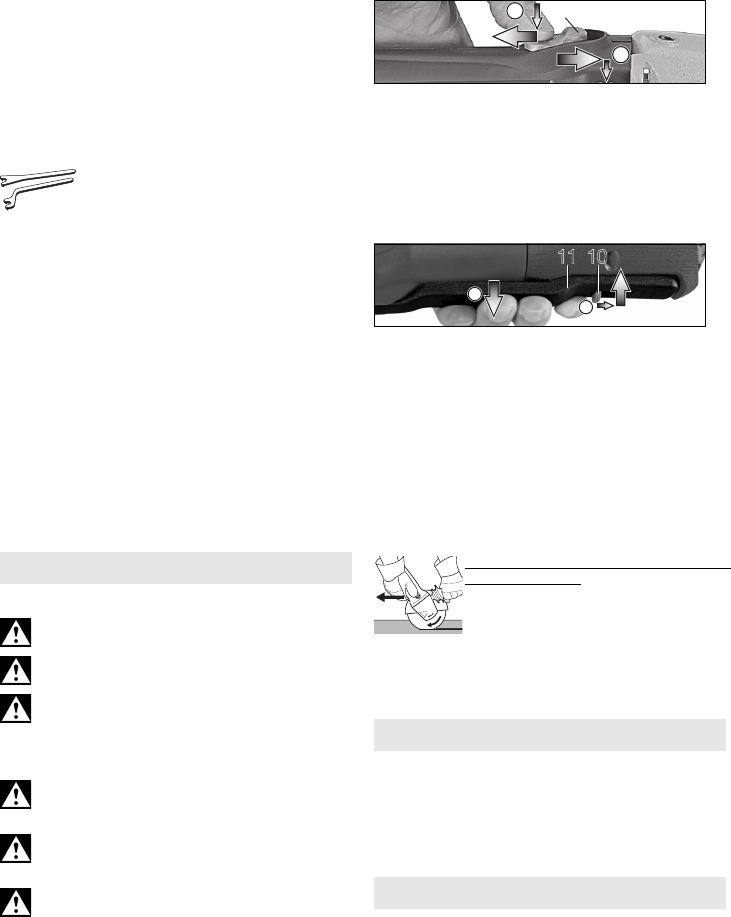
ENGLISHen
10
6.2 Placing the grinding wheel in position
See illustration C on page 2.
- Fit the support flange (1) on the spindle. The
flange should not turn on the spindle when prop-
erly attached.
- Place the grinding wheel on the support flange (1).
The grinding wheel must lay flat on the supporting
flange. The metal flange on the parting grinder
disc must lay flat on the support flange.
6.3 Tightening/loosening the clamping nut
Securing the clamping nut (16):
The 2 sides of the clamping nut are different. Screw
the clamping nut onto the spindle as follows:
See illustration D on page 2.
- A) For thin grinding wheels:
The edge of the clamping nut (16) faces upwards
so that the thin grinding wheel can be attached
securely.
B) For thick grinding wheels:
The edge of the clamping nut (16) faces down-
wards so that the clamping nut can be attached
securely to the spindle.
- Lock the spindle. Turn the clamping nut (16)
clockwise using the 2-hole spanner (17) to
secure.
Releasing the clamping nut:
- Lock the spindle (see chapter 6.1). Turn the
clamping nut (16) anticlockwise using the 2-hole
spanner (17) to unscrew.
7.1 Switching On and Off
Always guide the machine with both hands.
Switch on first, then guide the
accessory
towards the workpiece.
The machine must not be allowed to draw in
additional dust and shavings. When switching
the machine on and off, keep it away from dust
deposits. After switching off the machine, only place
it down when the motor has come to a standstill.
Avoid switching on the machine accidentally:
always switch it off when the battery pack is
removed from the machine.
Avoid inadvertent starts: always switch the
tool off when the plug is removed from the
mains socket or if there has been a power cut.
In continuous operation, the machine
continues running if it is forced out of your
hands. Therefore, always hold the machine with
both hands using the handles provided, stand in a
safe position and concentrate.
Machines with slide switch:
Switching on: Push the slide switch (6) forward.
For continuous activation, now tilt down-
wards until it engages.
Switching off: Press the rear end of the slide
switch (6) and release.
Machines with Paddle Switch (with dead man
function):
(machines with the designation WPF..., WEPF...)
Switching on: Slide the switch-on lock (8) in
the direction of the arrow and press
the trigger (9).
Switching off: Release the trigger (9).
7.2 Working instructions
Grinding and sanding operations:
Press down the machine evenly on the surface and
move back and forth so that the surface of the work-
piece does not become too hot.
Roughing: position the machine at an angle of 30° -
40° for the best working results.
Cutting-off:
Always work against the run of the disc
(see illustration). Otherwise there is
the danger of the machine kicking
back from the cut out of control. Guide
the machine evenly at a speed suit-
able for the material being processed. Do not tilt,
apply excessive force or sway from side to side.
Wire brushing:
Press down the machine evenly.
Motor cleaning: blow compressed air through the
rear ventilation slots of the machine regularly,
frequently and thoroughly. Here, the machine must
be held firmly.
Clean the dust filter regularly: remove and clean
with a jet of compressed air.
9.1 Mains powered machines:
- Overload protection: There is a MAJOR
reduction in load speed. The motor temperature
is too high! Allow the machine to run at idle speed
until it has cooled down.
- Overload protection: There is a SLIGHT
reduction in load speed. The machine is over-
7. Use
8. Cleaning
9. Troubleshooting
0
I
8
0
I
11 10


















